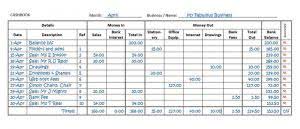Bookkeeping
Business Solutions for Truck Drivers

In this 21st century, there’s software to manage many aspects of a trucking business. Accounting and paperwork don’t bring me much pleasure so I use Fleet care. They check everything so I know that I don’t pay more than I have to, my tax return is submitted on time, ensuring I avoid penalties, that’s important for me. I mainly wanted a system designed for the industry that I would not have to go through and completely “edit” to make work for what we do, such as quick books. A way to itemize our expenses easily and show us where the money was going and annual, monthly and quarterly costs in just moments. Having an accountant do everything might sound like a great option – but the truth is it’s your business.
Additionally, Q7 offers both direct deposit and customizable checks. The system allows for batch payroll processing and customizable reporting, which includes summaries, tax audits, and W-2 printing for year-end. Lastly, you want to look for a bookkeeper that will also calculate your tax estimates. As an owner-operator, you have to pay quarterly tax estimates based on your profit.
Using the Right Tools
The amounts listed for each jurisdiction on the report are used to calculate a net balance. Any additional tax due is remitted to the base jurisdiction, or a credit or refund is issued. With the trucking software program from TruckingOffice.com you can keep up with invoices that are coming due and receive alerts if any payments are past due. This helps you improve your trucking company’s cash flow so that you will always be able to pay your drivers and other employees on time. Zoho Books facilitates online payment acceptance through integration with over ten third-party payment gateways, such as Stripe and PayPal.

FreshBooks is a cloud-based online accounting software solution that provides your company independent owner operator business with a host of features. FreshBooks will give you everything you need to manage and keep track of your small business transactions. No accounting experience necessary, no math required. QuickBooks has some great features, there is no doubt about that.
“I had no idea I was losing money on half of my loads”
Every business owner knows the stress of not knowing how much money their business is making. Price differences will also depend on the size of your fleet. You can save considerably more on software just by operating a small fleet, though some plans offer discounts for enterprise-level trucking operations. Others require a minimum number of qualified motor vehicles (QMV) per fleet. Your business’s budget is a crucial document that outlines how funds are designated to be spent in the following year in your organization.

Maybe you’ve tried to piece together several different types of software to create a usable system that works for you. What we are offering in our Trucking Office software is all of those features and more in one trucking-specific software solution. That’s the main reason we put our heads together and developed our Trucking Office software for owner-operators. We are truckers ourselves, and we know what kind of features owner-operators need to run their trucking company with convenience and ease.
Tips for Choosing the Right Bookkeeping Service
Rigbooks supports IFTA compliance by tracking mileage per jurisdiction and providing detailed information for tax reporting. The software can also generate profit and loss reports, truckers bookkeeping offering insights into the company’s fiscal performance. Additionally, TruckLogics integrates with popular accounting software like QuickBooks to synchronize data.
- With the Hub, you’ll be able to scan or import receipts, settlements, and other documents with just a few taps.
- In a few weeks of tracking your business, you’ll gain a crystal-clear view of your most important business decisions.
- As I said yesterday, I feel like OOBT will be an incredible asset to the success of my business.
- The key to successful LTL trucking is all in the load planning.
- We are here to help you understand your business’ financial health, finance new equipment or repairs, acquire insurance, and align with carriers.

